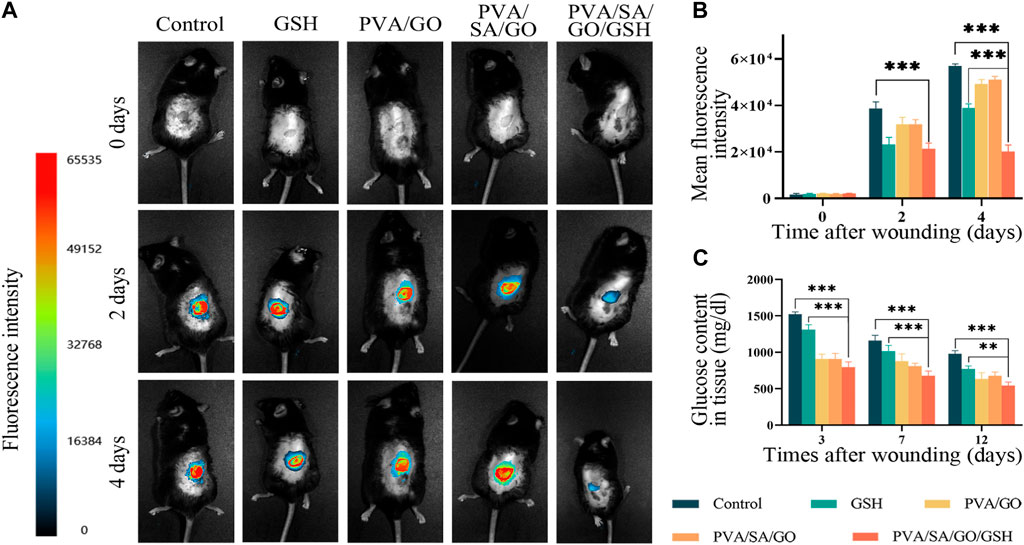Double cross-linked graphene oxide hydrogel for promoting healing of diabetic ulcers
- 1Lab of Neurology, The Affiliated Hospital of Guilin Medical University, Guilin, China
- 2School of Pharmacy, Guilin Medical University, Guilin, China
- 3Health Management Centre, The Second Affiliated Hospital of Guilin Medical University, Guilin, China
- 4Clinical Research Center for Neurological Diseases of Guangxi Province, The Affiliated Hospital of Guilin Medical University, Guilin, China
A Corrigendum on
Double cross-linked graphene oxide hydrogel for promoting healing of diabetic ulcers
by Liu W, Yang Y, Li M and Mo J (2024). Front. Chem. 12:1355646. doi: 10.3389/fchem.2024.1355646
In the published article, there was an error in Figure 7. The corrected figure and its caption appear below.

Figure 7. Impact of hydrogel treatment on wound healing and reactive oxygen species (ROS) scavenging. (A) Representative fluorescence images of wounds from day 0 to day 4; (B) Statistical analysis of average fluorescence intensity levels. (C) Quantitative analysis of glucose content in the wound tissues. Data are presented as means ± standard deviation. Statistically significant differences are denoted by asterisks, with **p ≤ 0.01, ***p ≤ 0.001.
In the published article, there was an error in Figure 9. The corrected figure and its caption appear below.

Figure 9. The effects of hydrogel on the microenvironment of the wound and the promotion of the healing of chronic diabetic wounds. Immunohistochemical staining was performed to detect the expression of (A) VEGF, (B) CD31, (C) Ki67, (D) CD86, and (E) CD163 (positive staining is brownish, nucleus staining is purple). Scale bar is 100 μm. Quantitative analysis of (F) VEGF, (G) CD31, (H) Ki67, (J) CD86, and (K) CD163 immunohistochemical staining was also performed. (I) ELISA was used to detect the expression of VEGF in the traumatic tissues. Data are presented as means ± standard deviation. Statistically significant differences are denoted by asterisks, with*p ≤ 0.05, **p ≤ 0.01, ***p ≤ 0.001.
The authors apologize for these errors and state that this does not change the scientific conclusions of the article in any way. The original article has been updated.
Publisher’s note
All claims expressed in this article are solely those of the authors and do not necessarily represent those of their affiliated organizations, or those of the publisher, the editors and the reviewers. Any product that may be evaluated in this article, or claim that may be made by its manufacturer, is not guaranteed or endorsed by the publisher.
Keywords: bioorthogonal click, graphene oxide, dual network hydrogel, diabetic ulcer damage, glutathione
Citation: Liu W, Yang Y, Li M and Mo J (2024) Corrigendum: Double cross-linked graphene oxide hydrogel for promoting healing of diabetic ulcers. Front. Chem. 12:1393387. doi: 10.3389/fchem.2024.1393387
Received: 29 February 2024; Accepted: 14 March 2024;
Published: 22 March 2024.
Approved by:
Frontiers Editorial Office, Frontiers Media SA, SwitzerlandCopyright © 2024 Liu, Yang, Li and Mo. This is an open-access article distributed under the terms of the Creative Commons Attribution License (CC BY). The use, distribution or reproduction in other forums is permitted, provided the original author(s) and the copyright owner(s) are credited and that the original publication in this journal is cited, in accordance with accepted academic practice. No use, distribution or reproduction is permitted which does not comply with these terms.
*Correspondence: Jingxin Mo, amluZ3hpbi5tb0Bob3RtYWlsLmNvbQ==
 Wenxu Liu1,2
Wenxu Liu1,2 Jingxin Mo
Jingxin Mo